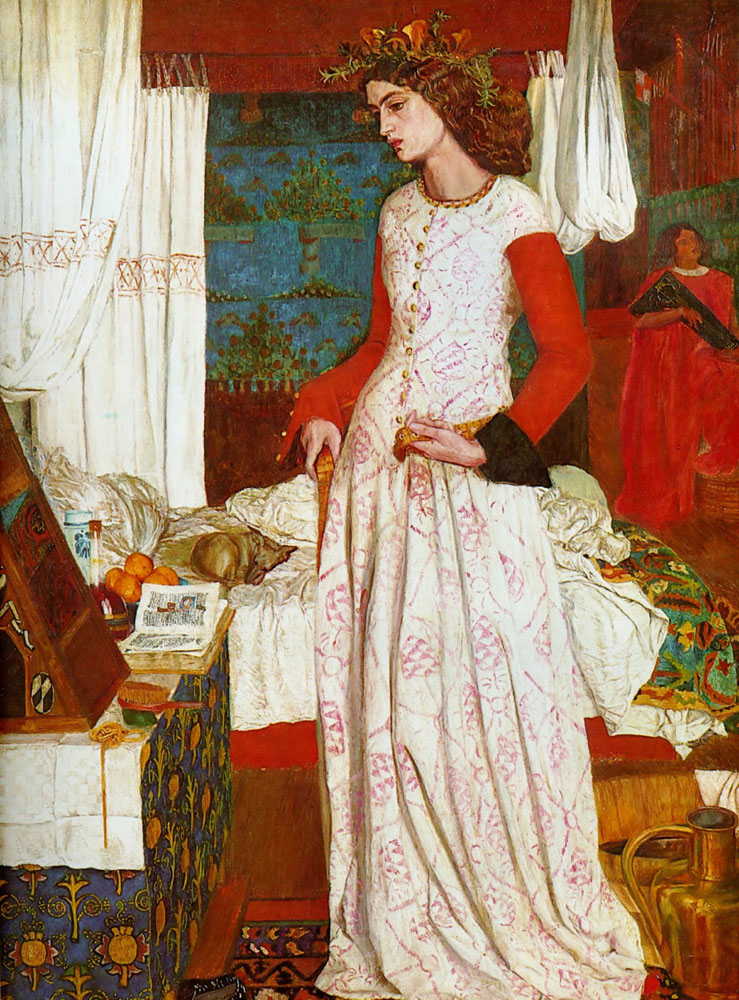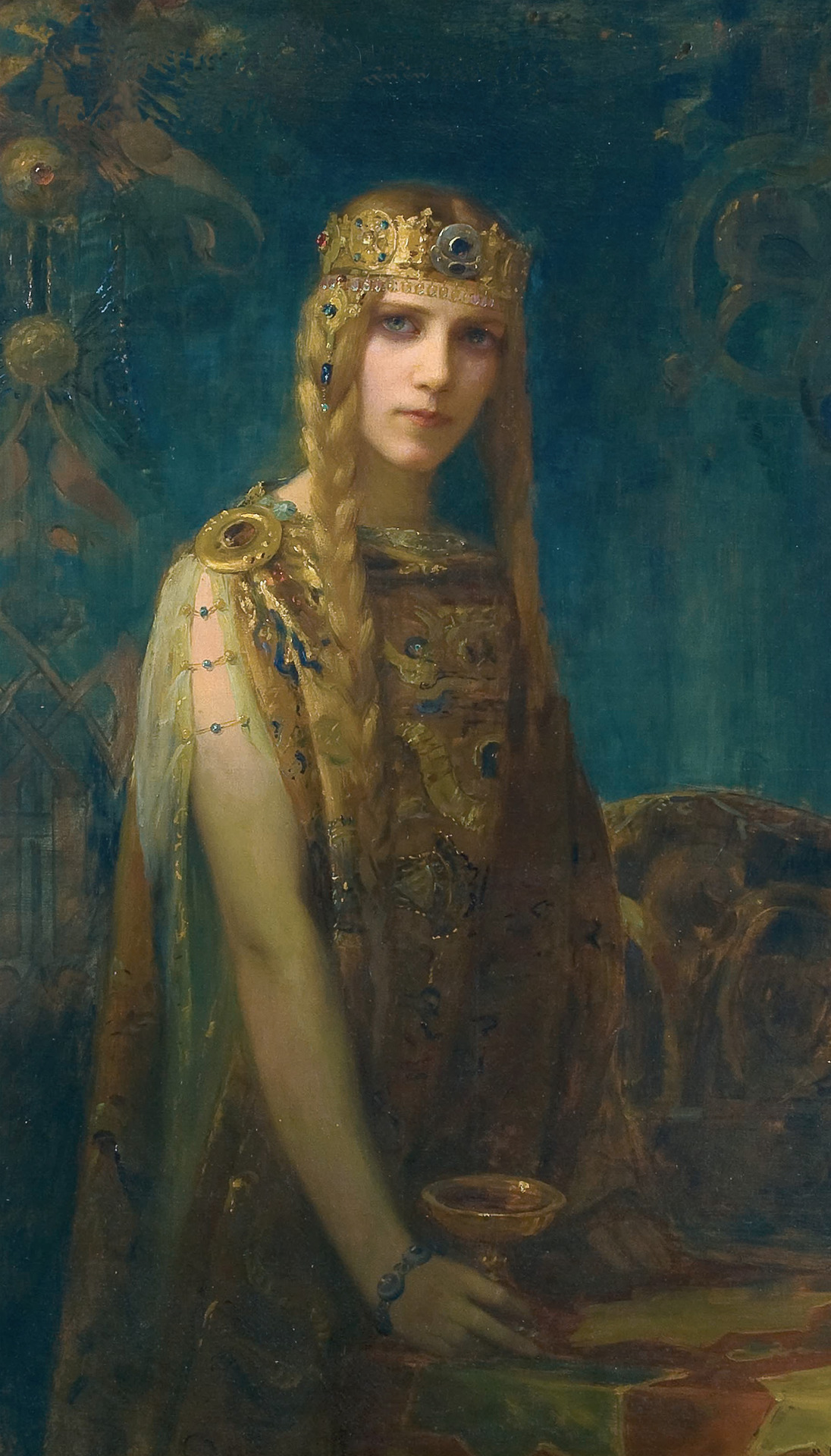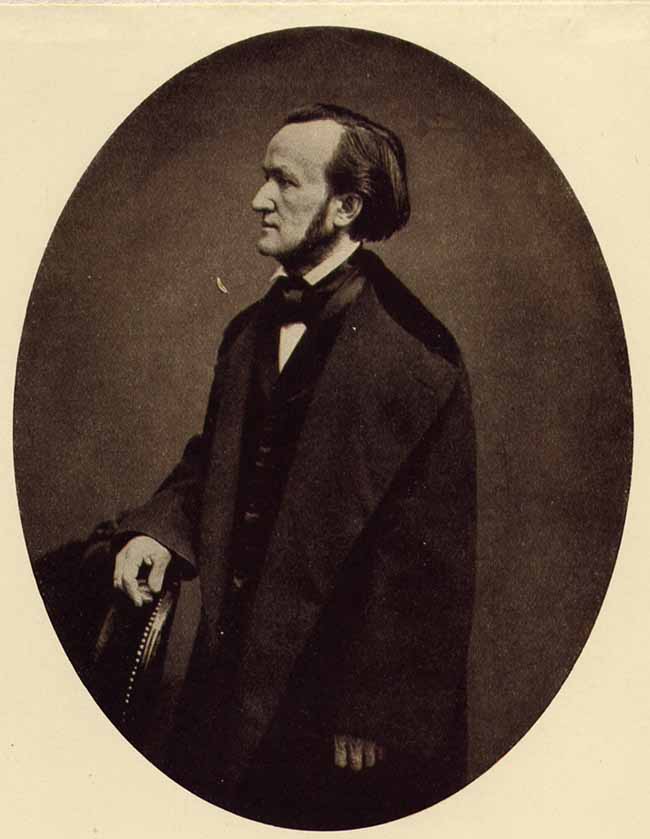|
Iseult
Iseult ( ), alternatively Isolde ( ) and other spellings, is the name of several characters in the legend of Tristan and Iseult. The most prominent is Iseult the Blonde, or Iseult of Ireland, the wife of Mark of Cornwall and the lover of Tristan. Her mother, the queen of Ireland, is also named Iseult. The third is Iseult of the White Hands, or Iseult of Brittany, the daughter of Hoel and the sister of Kahedin. Name Her name is variably given as most commonly either Iseult or Isolde, but also may appear as Yseult, Ysolt, Isolt, Isode, Isoude, Iseut, Isaut (Old French), Iosóid (Irish), Esyllt (Welsh), Ysella (Cornish), Isolda (Portuguese, Spanish), Izolda (Serbian) and Isotta (Italian), among other forms. The oldest source, Béroul's 12th-century romance, spells her name as ''Yseut'' or ''Iseut''. The etymology is uncertain, with most sources linking it to the Old High German words ''īs'' ("ice") and ''hiltja'' ("battle"). Other writers derive it from a Brythonic *''Adsilt ... [...More Info...] [...Related Items...] OR: [Wikipedia] [Google] [Baidu] |
Tristan And Iseult
Tristan and Iseult, also known as Tristan and Isolde and other names, is a medieval chivalric romance told in numerous variations since the 12th century. Of disputed source, usually assumed to be primarily Celtic nations, Celtic, the tale is a tragedy about the illicit love between the Cornish people, Cornish knight Tristan and the Irish princess Iseult in the days of King Arthur. During Tristan's mission to escort Iseult from Ireland in the Middle Ages, Ireland to marry his uncle, King Mark of Cornwall, Tristan and Iseult ingest a love potion, instigating a forbidden love affair between them. The legend has had a lasting impact on Western culture. Its different versions exist in many European texts in various languages from the Middle Ages. The earliest instances take two primary forms: the so-called courtly and common branches, respectively associated with the 12th-century poems of Thomas of Britain and Béroul, the latter believed to reflect a now-lost original tale. A subse ... [...More Info...] [...Related Items...] OR: [Wikipedia] [Google] [Baidu] |
Isolde - Illustration By Percy Anderson For Costume Fanciful, Historical And Theatrical, 1906
Iseult ( ), alternatively Isolde ( ) and other spellings, is the name of several characters in the legend of Tristan and Iseult. The most prominent is Iseult the Blonde, or Iseult of Ireland, the wife of Mark of Cornwall and the lover of Tristan. Her mother, the queen of Ireland, is also named Iseult. The third is Iseult of the White Hands, or Iseult of Brittany, the daughter of Hoel and the sister of Kahedin. Name Her name is variably given as most commonly either Iseult or Isolde, but also may appear as Yseult, Ysolt, Isolt, Isode, Isoude, Iseut, Isaut (Old French), Iosóid (Irish), Esyllt (Welsh), Ysella (Cornish), Isolda (Portuguese, Spanish), Izolda (Serbian) and Isotta (Italian), among other forms. The oldest source, Béroul's 12th-century romance, spells her name as ''Yseut'' or ''Iseut''. The etymology is uncertain, with most sources linking it to the Old High German words ''īs'' ("ice") and ''hiltja'' ("battle"). Other writers derive it from a Brythonic *''Adsilt ... [...More Info...] [...Related Items...] OR: [Wikipedia] [Google] [Baidu] |
Brangaine
Brangaine (variously spelled Brangaene, Brangwane, Brangien, Brangwin, etc.) is the handmaid and confidante of Iseult of Ireland in the Arthurian legend of Tristan and Iseult. She appears in most versions of the story. Narrative Brangaine plays essentially the same role in the early poetic versions of Béroul and Thomas of Britain, and their respective German successors Eilhart von Oberge and Gottfried von Strassburg. She is the inadvertent catalyst in the development of the story's central romance: before Tristan takes Iseult back to Cornwall to be the wife of his uncle King Mark, Iseult's mother (also named Iseult) entrusts Brangaine with a love potion meant for Iseult and her new husband to drink on their wedding night. However, Tristan and Iseult find the potion on the boat ride to Cornwall, and mistaking it for regular wine, they drink it. So begins their unstoppable passion. Upon arrival in Cornwall, the virgin Brangaine plays a second important role: she secretly substit ... [...More Info...] [...Related Items...] OR: [Wikipedia] [Google] [Baidu] |
Prose Tristan
The Prose ''Tristan'' ( French: '' oman de' ''Tristan en prose''), also known as ''Tristan de Léonois,'' is a 13th-century Old French adaptation of the Tristan and Iseult">-4; we might wonder whether there's a point at which it's appropriate to talk of the beginnings of French, that is, when it wa ... adaptation of the Tristan and Iseult story into a lengthy prose romance (heroic literature), romance. It was the first to tie the subject entirely into the arc of the Arthurian legend, making the hero Tristan a member of the Round Table. It was also the first major Arthurian prose cycle commenced after the widely popular ''Lancelot-Grail'' (Vulgate Cycle), which influenced especially the later portions of the Prose ''Tristan''. It exists in multiple distinct variants, notably the "short" and the "long" versions. Versions According to the traditional, but since long and much debated theory, there have been the original "short version" also known as the First Version or Version I ... [...More Info...] [...Related Items...] OR: [Wikipedia] [Google] [Baidu] |
King Mark
Mark of Cornwall (, , , ) was a sixth-century King of Kernow (Cornwall), possibly identical with King Conomor. As Mark or Marc (''Marc'h''), he is best known for his appearance in Arthurian legend as the uncle of Tristan and the husband of Iseult, who engages with Tristan in a secret liaison, giving Mark the epithet "Cuckold King". King Mark In Old Welsh records, Mark is recorded as "March son of Meirchion" of Kernow (Cornwall). He is associated with governing portions of Gwynedd and Glamorgan in Wales. The distance of these areas from modern day Cornwall may indicate that Mark was in fact a ruler of the eponymous Cornovii. Mark has been identified with Conomor, a king of Domnonea and Kernev (Domnonée and Cornouaille) in Armorica. In his ''Life of St. Pol de Leon'', Wrmonoc of Landévennec refers to a "King Marc whose other name is Quonomorus". Also rendered as ''Cunomorus'', the name means "Hound-of-the-sea".Thomas, Charles (1986). ''Celtic Britain''. London: Thames ... [...More Info...] [...Related Items...] OR: [Wikipedia] [Google] [Baidu] |
Mark Of Cornwall
Mark of Cornwall (, , , ) was a sixth-century King of History of Cornwall, Kernow (Cornwall), possibly identical with King Conomor. As Mark or Marc (''Marc'h''), he is best known for his appearance in King Arthur, Arthurian legend as the uncle of Tristan and the husband of Iseult, who engages with Tristan in a secret liaison, giving Mark the epithet "Cuckold King". King Mark In Old Welsh records, Mark is recorded as "March son of Meirchion" of Kernow (Cornwall). He is associated with governing portions of Gwynedd and Glamorgan in Wales. The distance of these areas from modern day Cornwall may indicate that Mark was in fact a ruler of the eponymous Cornovii. Mark has been identified with Conomor, a king of Domnonea and Kernev (Domnonée and Cornouaille) in Armorica. In his ''Life of St. Paul Aurelian, Pol de Leon'', Wrmonoc of Landévennec refers to a "King Marc whose other name is Quonomorus". Also rendered as ''Cunomorus'', the name means "Hound-of-the-sea".Thomas, Charles ... [...More Info...] [...Related Items...] OR: [Wikipedia] [Google] [Baidu] |
Tristan
Tristan (Latin/ Brythonic: ''Drustanus''; ; ), also known as Tristran or Tristram and similar names, is the folk hero of the legend of Tristan and Iseult. While escorting the Irish princess Iseult to wed Tristan's uncle, King Mark of Cornwall, Tristan and Iseult accidentally drink a love potion during the journey and fall in love, beginning an adulterous relationship that eventually leads to Tristan's banishment and death. The character's first recorded appearance is in the 12th-century poetic tellings initiated by Béroul and Thomas of Britain, which were eventually vastly expanded in the later tradition from the vast Prose ''Tristan''. In later versions of his story he is featured in Arthurian legend, including the seminal compilation ''Le Morte d'Arthur'', as a great Knight of the Round Table and friend of Lancelot. The historical roots of Tristan are unclear; his association with Cornwall may originate from the Tristan Stone, a 6th-century granite pillar in C ... [...More Info...] [...Related Items...] OR: [Wikipedia] [Google] [Baidu] |
Kahedin
Sir Kahedin (variantly spelled Kahadin, Kahedrin, Kaherdin, Kehenis, Kehidius; possibly the Welsh character Kae Hir) is brother to Iseult of Brittany and the son of King Hoel of Brittany in Arthurian legend. The story of his affair with Brangaine, the handmaiden of Iseult of Ireland is significantly mentioned in the Tristan and Iseult legend. Narrative Kahedin first meets Brangaine in the Hall of Images, where he was previously sent to deliver a message to Iseult of Ireland regarding the arrival of her lover, Sir Tristan Tristan (Latin/ Brythonic: ''Drustanus''; ; ), also known as Tristran or Tristram and similar names, is the folk hero of the legend of Tristan and Iseult. While escorting the Irish princess Iseult to wed Tristan's uncle, King Mark of .... He conveys the message and Iseult and Tristan spend the night in a wooden cabin. Meanwhile, Kahedin prepares to spend the night with Brangaine after receiving favourable advances from her. When they go to bed, how ... [...More Info...] [...Related Items...] OR: [Wikipedia] [Google] [Baidu] |
Chapelizod
Chapelizod () is a suburban village of Dublin, Ireland. It lies in the wooded valley of the River Liffey, near the Strawberry Beds and the Phoenix Park. The village is associated with Iseult of Ireland and the location of Iseult's chapel. Chapelizod is under the administration of Dublin City Council. Location The civil parish of Chapelizod is part of the barony of Castleknock. The parish consists of a single townland of the same name. However, 465 acres are within the walls of the Phoenix Park while the village proper, outside the walls, contains only 67 acres. It is the only parish of the barony that lies outside the territory of the modern county of Fingal. Chapelizod forms part of the local electoral area of Ballyfermot–Drimnagh within the Dublin City Council administrative area. History The origins of Chapelizod are obscure. There is evidence of Neolithic settlement between the southern ridge of the Phoenix Park and the Liffey and several burial mounds exist to the ... [...More Info...] [...Related Items...] OR: [Wikipedia] [Google] [Baidu] |
Hoel
King Hoel (, "Hoel the Great"; ), also known as Sir Howel, Saint Hywel and Hywel the Great, was a late 5th- and early 6th-centuryFord, David Nashat ''Early British Kingdoms''. 2001. Retrieved 1 December 2014. member of the ruling dynasty of Cornouaille. He may have ruled Cornouaille jointly after the restoration of his father, Budic II of Brittany, but he seems to have predeceased his father and left his young son, Tewdwr, as Budic's heir.Ford, David Nash"Tewdwr Mawr"at ''Early British Kingdoms''. 2001. Retrieved 1 December 2014. Hywel appears in Welsh mythology and the Matter of Britain as a " king of Brittany." A relative of Arthur, he was one of his most loyal allies (or, sometimes, a Knight of the Round Table) and was said to have helped him conquer "Gaul" (northern France). Life The historical Hywel was the son of Budic II, king of Cornouaille in northwest Brittany. For all or most of his childhood, a usurping cousin ruled in Budic's place and the family resided ... [...More Info...] [...Related Items...] OR: [Wikipedia] [Google] [Baidu] |
Tristan Und Isolde
''Tristan und Isolde'' (''Tristan and Isolde''), WWV 90, is a music drama in three acts by Richard Wagner set to a German libretto by the composer, loosely based on the medieval 12th-century romance ''Tristan and Iseult'' by Gottfried von Strassburg. First conceived in 1854, the music was composed between 1857 and 1859 and premiered at the Königliches Hoftheater und Nationaltheater in Munich on 10 June 1865 with Hans von Bülow conducting. While performed by opera companies, Wagner preferred the term ''Handlung'' (German for "plot" or "action") for ''Tristan'' to distinguish its structure of continuous narrative flow (" endless melody") as distinct from that of conventional opera at the time which was constructed of mundane recitatives punctuated by showpiece arias, which Wagner had come to regard with great disdain. Wagner's composition of ''Tristan und Isolde'' was inspired in part by the philosophy of Arthur Schopenhauer, as well as by his relationship with his muse ... [...More Info...] [...Related Items...] OR: [Wikipedia] [Google] [Baidu] |
Morholt
The Knights of the Round Table (, , ) are the legendary knights of the fellowship of King Arthur that first appeared in the Matter of Britain literature in the mid-12th century. The Knights are a chivalric order dedicated to ensuring the peace of Arthur's kingdom following an early warring period, entrusted in later years to undergo a mystical quest for the Holy Grail. The Round Table at which they meet is a symbol of the equality of its members, who range from sovereign royals to minor nobles. The various Round Table stories present an assortment of knights from all over Great Britain and abroad, some of whom are even from outside of Europe. Their ranks often include Arthur's close and distant relatives, such as Agravain, Gaheris and Yvain, as well as his reconciled former enemies, like Galehaut, Pellinore and Lot. Several of the most notable Knights of the Round Table, among them Bedivere, Gawain and Kay, are based on older characters from a host of great warriors associa ... [...More Info...] [...Related Items...] OR: [Wikipedia] [Google] [Baidu] |









